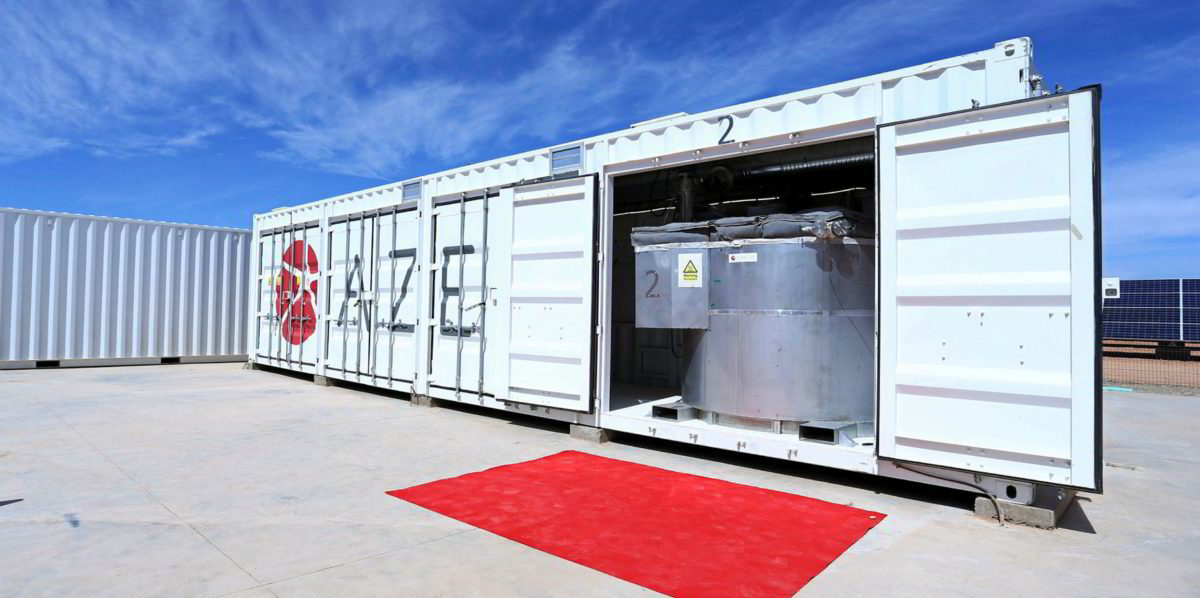From pv magazine USA
Siemens Energy and EnergyNest have entered into a long-term partnership to develop thermal energy storage solutions for industrial customers. The two companies are exploring the use of excess renewable electricity to charge a thermal battery, which would in turn release steam when needed to provide power — lowering the plant’s natural gas demand, while increasing flexibility.
Niche tech
Thermal storage has long been considered vital to decarbonization, yet the market for the technology has remained niche and expensive. This is a reality recognized by Siemens and EnergyNest, with the two companies laying out their intent to create modularized and standardized thermal storage systems – improving both the efficiency and economics of the technology into a scalable model.
Thermal storage is currently a $4.35 billion market, small potatoes in the energy world. And while the technology is currently held back by limited efficiency and even more limited project economics, proponents of the technology hold to the idea that thermal storage can offer higher power capacity, improved cycle life and better overall system reliability, in comparison to lithium-ion batteries.
Siemens and EnergyNest aren’t the only companies operating in the thermal storage sector, so what other innovations are being made to guide this niche technology into the mainstream?
Development stage
It’s not just private companies looking to expand the scope of thermal storage. The National Renewable Energy Laboratory (NREL) has launched a project aimed at increasing the efficiency of thermal storage to then use the energy to drive a turbine-generator set. Specifically, NREL is looking to develop a system that uses electricity to power a high-performance heat exchanger, which will heat inexpensive solid particles to over 1,100 C. The particles will be stored in insulated silos for up to several days. When electricity is desired, the hot particles will be fed through a fluidized bed heat exchanger, heating a working fluid to drive a Brayton combined-cycle turbine attached to a generator.
Speaking of Brayton Energy, the company is currently developing what it calls a “key component” to integrate turbomachinery into a cost-competitive thermal energy storage system. In English, that means that Brayton is looking to create a system in which each turbo-machinery stage is designed to act as both a compressor and turbine, alternating between charging and discharging cycles. This system simplification and consolidation of parts is expected to increase efficiency and reduce capital costs.
In 2018, Echogen began development of an energy storage system that, according to the company, uses a CO2 heat pump cycle to convert electrical energy to thermal energy by heating a “reservoir” of low cost materials such as sand or concrete. The reservoir then retains the heat, which will be converted back into electricity on demand. To generate power, liquid CO2 will be pumped through the high-temperature reservoir to a supercritical state, after which it will expand through a turbine to generate electricity from the stored heat.
These three development projects are being carried under a quasi-competing series of grants given out by ARPA-E, in pursuit of getting long-duration storage costs down to 5 cents per kWh. The grants include more than just thermal storage, and have been covered previously by pv magazine.
While development and research interest in thermal storage is quite easy to come by, commercial projects and fully-realized solutions are another matter entirely.
Molten aluminum
Swedish startup Azelio – which stores energy in molten aluminum – has made the breakthrough into commercial molten-storage projects. One of the company’s storage solutions has been installed alongside the 580 MW Noor Ouarzazate solar complex (510 MW of CSP and 70 MW of PV), in Morocco. Azelio’s technology uses electricity to heat recycled aluminum to 600 C. When power is required from the storage unit, the stored thermal energy is transported to a Stirling engine using a heat-transfer fluid.
Just this past week, the company signed a memorandum of understanding with US-based Trimark Associates, for more than 45 MW capacity of Azelio’s energy storage until 2025, with Trimark serving as system integrator, in an attempt for Azelio to get a foothold in the American market. The first projects are targeting 150 kW in 2021, followed by 3 MW in 2022, 6 MW in 2023, 12 MW in 2024, and 24 MW in 2025.
1414 Degrees
Headquartered out of Adelaide, Australia, 1414 Degrees is a molten silicon thermal storage company looking to deliver thermal storage solutions for customers with needs ranging from 10 MWh to 1 GWh. The silicon is stored at 1414 degrees, hence the name.
The company made waves at the end of 2019 after purchasing the company SolarReserve Australia II, which owns the Aurora Solar Energy Project near Port Augusta in South Australia. This project is a 220 MW combination of 70 MW of PV and 150 MW of concentrated solar power that 1414 Degrees is seeking permission to expand by adding 400 MW of PV.
The company intends to use the Aurora project to pilot its TESS-GRID thermal storage technology and deliver stable power to the grid.
This content is protected by copyright and may not be reused. If you want to cooperate with us and would like to reuse some of our content, please contact: editors@pv-magazine.com.




Check out Brenmiller Energy, we are the only commercial technology for thermal storage, a listed company, and cooperating with global leaders such as Enel and NYPA.
Ideal for breweries and distilleries with a high year round demand for heat, not so efficient if it cannot operate in CHP mode.